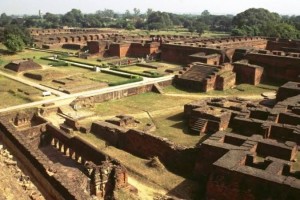
 By Nandini Bhushan
By Nandini Bhushan
Bihar has derived its name from the word “Vihar”, which means monastery, a place where monks lived together. It was here that Buddhism flourished in its initial day and the region was dotted with some of the important Buddhist monasteries or Vihars.
Such is the essence of its historical importance that Bihar itself represents history. Indian civilisation is believed to be one of the oldest civilisations in the world and Bihar has occupied the central place of activity and the seat of power for a major period of this great civilisation.
Yet, despite its historical importance, Bihar has been quite underrated and not a popular destination among tourists exploring the places witnessing great moments of history, largely because of the ignorance of people, just as most people are about Bihari cuisine. The fact is that Bihar has been an integral part of our glorious Indian history, yet it remains an unexplored historical travel destination, and has therefore been quite underrated among tourists. Blessed with remarkable relics and monuments from ancient dynasties and deeply linked with Indian history as a spiritual and learning center, it definitely deserves better treatment.
In this blog, I bring to you the historical sites of Bihar and its glorious past. Here is Bihar from the lens of an avid history lover to give you a chance to peep in the rich heritage of this glorious land of Buddha.
Nalanda University

Although in the modern scenario more and more students are moving out of Bihar in search of quality education, there was a time when Bihar was the birthplace and home to several ancient educational institutions and Universities. The history of ancient universities and buddhist monastic centres dates back to the time of Buddha and Mahavira, the founder of Jain religion, when students from all across the globe visited here for higher studies.
Situated at about 95 kilometres from the capital city of Bihar, Nalanda University was one of the greatest education centres from the 5th century CE to 1200 CE . The ancient kingdom of Magadh was a renowned for the centre of learning that lasted for about 800 years. The foundation of Nalanda University was laid by Gupta Emperor Kumar Gupta 1 in the 5th century CE. Nalanda prospered in the fifth and sixth centuries under the patronage of the Gupta Empire and later under Harsha, the emperor of Kannauj. Sadly, Nalanda University was destroyed thrice and was rebuilt twice. It was eventually ransacked and demolished in 1200 CE by the Mamluk Dynasty of Delhi Sultanate under Bakhtiyar Khilji who killed the monks and put the library on fire.
Also read: Tourist places of Bihar: A glimpse into ancient Magadh -Part 3

The ruins of Nalanda University still remains unexcavated and many untold stories are buried in them. Excavated ruins are spread over an area of 150,000 square feet. The premises of the university stretches across 0.75 km in width and 1.5 km in length. The remains narrate the stories of advanced academic culture as it housed 11 monasteries, three library Towers and an astronomical centre. There were about 300 rooms for the residential students and travellers and about eight halls to host events and meetings. The high point of the entire structure is the Sariputta stupa. The Stupa has multiple pairs of stairs leading to the centre of an Apex to hold a Buddhist Shrine.
 The library of Nalanda University “dharma Gunj” meaning “mountain of truth ” had a very rich collection with hundreds and thousands of volumes of books and it took almost a period of three months to completely burn out. The architecture was remarkable and was no less than any of the modern-day University towns providing boarding as well as lodging facility for the students. Chinese traveller Hiuen Tsang visited Nalanda in the seventh century AD and gave a detailed account of the excellent education system . He had also written a detailed description about the architecture and ambiance of this ancient University. It was indeed the first ever International University of the world with two thousand teachers and ten thousand monks who lived and studied here. The monasteries are built in kusher architectural style and have a row of cells around the courtyard. It is an example of the remarkable architecture wonder of Gupta empire.The periodic design is aesthetic and that of skilled craftsmanship.
The library of Nalanda University “dharma Gunj” meaning “mountain of truth ” had a very rich collection with hundreds and thousands of volumes of books and it took almost a period of three months to completely burn out. The architecture was remarkable and was no less than any of the modern-day University towns providing boarding as well as lodging facility for the students. Chinese traveller Hiuen Tsang visited Nalanda in the seventh century AD and gave a detailed account of the excellent education system . He had also written a detailed description about the architecture and ambiance of this ancient University. It was indeed the first ever International University of the world with two thousand teachers and ten thousand monks who lived and studied here. The monasteries are built in kusher architectural style and have a row of cells around the courtyard. It is an example of the remarkable architecture wonder of Gupta empire.The periodic design is aesthetic and that of skilled craftsmanship.
The faculty came from all over the world like China, Japan, Tibet, Korea, Greater Iran, Indonesia, Persia, Mongolia to name a few. Dharam Pala, dharm shanta, Rakshita, padmasambhava and Xuanzang were few of the famous scholars who were alumni of Nalanda University.

The Pali inscription on the stone tablets and walls of Nalanda are evidence of how well versed the community was at that time. The Nalanda archaeological museum near the Heritage site displays rich sculptures, coins, seals and inscriptions that have been excavated from the ruins.
A visit to Nalanda University is a must if one is inclined towards ancient Indian education since the visit to the ruins enriches one’s journey into history, architecture and Buddhism





